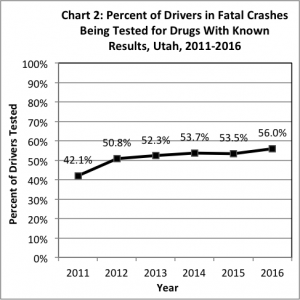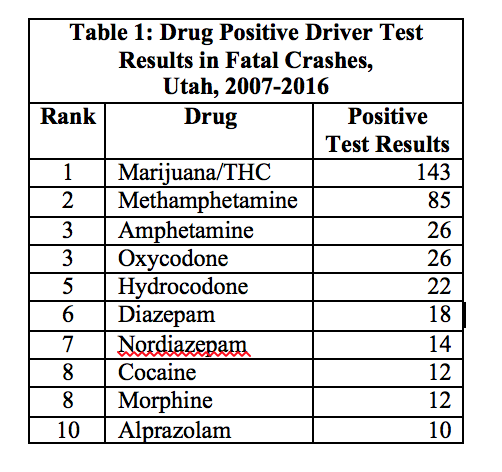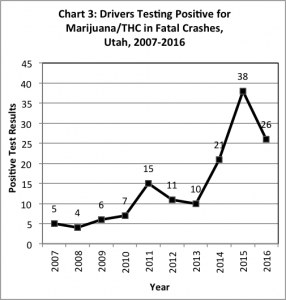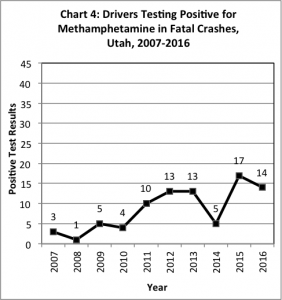Hot Topics and Research
BAC Information
BAC in Fatal Crashes 2007-2016 0.05-BAC-Fact-Sheet-March-2017
June 2017: Drugs and Driving
Click here for a PDF of the Hot Topic
The use of drugs (including illegal, prescription, and over-the-counter) can make driving a motor vehicle unsafe. The effects of specific drugs differ depending on how they act in the brain. Drug impaired driving is a complex problem due to the large number of substances with the potential to impair driving and increase crash risk, the variations in the ways different drugs can impair driving, the lack of basic information about many potentially impairing drugs, and the differences in the ways that drugs can affect the body and behavior. The behavioral effects of drugs are not as well understood as the behavioral effects of alcohol. Certain generalizations can be made: high doses generally have a larger effect than small doses; well-learned tasks are less affected than novel tasks; and certain variables, such as prior exposure to a drug, can either reduce or accentuate expected effects, depending on circumstances. The ability to predict an individual’s performance at a specific dosage of drugs other than alcohol is limited.1
Note: Drug presence does not necessarily imply impairment. For many drug types, drug presence can be detected long after any impairment that might affect driving has passed. Also, whereas the impairment effects for various concentration levels of alcohol is well understood, little evidence is available to link concentrations of other drug types to driver performance. An important distinction to make when evaluating drugged driving data is the mere presence of a drug in a person’s system, as compared to the person being impaired by a drug in his/her system. Drug test data provides information about drug presence, rather than whether the driver was impaired by a drug at the time of a crash. Data identifying a driver as “drug positive” indicates only that a drug was in his/her system at the time of the crash. It does not indicate that a person was impaired by the drug. Thus, knowing that a driver tested positive for drugs does not necessarily indicate that the person was impaired by the drug at the time of the crash.1-2
The number of deaths involving a drug positive driver in a motor vehicle crash has shown an increasing trend. In 2007 there were 18 motor vehicle deaths involving a drug positive driver. Ten years later in 2016 there were 82 deaths. See chart 1 for a display by year. All data is from the Utah Department of Public Safety, Highway Safety Office.
Testing
Some of the increase in positive drug tests may be due to an increase in the number of drivers in fatal crashes that are tested for drugs with the results being reported to the Fatality Analysis Reporting System (FARS). The percent of drivers over the last five years (2012-2016) that were tested has seen a slight increase from 50.8% in 2012 to 56.0% in 2016. See Chart 2 for a display by year.
Which drugs are drivers testing positive for?
Marijuana is far and away the most common drug that drivers are testing positive for in fatal crashes. There were 143 positive test results for marijuana/THC over the last 10 years. Methamphetamine is a clear second place with 85 positive test results. See Table 1 for a list of the top drugs drivers are testing positive for in fatal crashes in Utah over the last 10 years.
Marijuana
Marijuana is the most commonly used illegal drug in the United States. Research studies have shown negative effects of marijuana on drivers, including an impairment of judgment of time and distance, decrease in motor coordination, increase in lane weaving, poor reaction time, and decrease in attention to the road.3-6
Marijuana is the leading drug found among drug positive drivers in fatal crashes in Utah. There have been 143 drivers in fatal crashes over the last 10 years that tested positive for marijuana. This is much higher than any other drug. In addition, marijuana positive tests among drivers in fatal crashes have skyrocketed the last three years. Drivers testing positive for marijuana have increased from 10 in 2013 to 26 in 2016, with a high of 38 in 2015. See Chart 3 for a display by year.
Methamphetamine
Methamphetamine is an extremely addictive stimulant drug. It can be prescribed by a doctor to treat attention deficit hyperactivity disorder (ADHD) and other conditions, although it is rarely used medically, and only at doses much lower than those typically abused. 7 Methamphetamine can lead drivers to be aggressive and reckless when driving.8 Methamphetamine is the second highest drug that drivers are testing positive for in fatal crashes. There have been 85 positive test results for methamphetamine over the last 10 years. Most (73%) of these positive test results have been over the last 5 years. See Chart 4 for a display by year.
Prescription Drugs
Some prescription drugs have mind-altering properties and, because of that, are sometimes taken for reasons or in ways or amounts not intended by a doctor, or taken by someone other than the person for whom they are prescribed. Commonly abused classes of prescription drugs include opioids (for pain), central nervous system depressants (for anxiety and sleep disorders), and stimulants (for ADHD and narcolepsy). It is hard to distinguish between legal and illicit use of prescription drugs.9
After the top two drugs, the majority of the rest of the ten highest drugs are prescription drugs. Keep in mind that the total positive driver test results for the third through tenth highest drugs are about the same as the total for just marijuana.
Oxycodone (#3), Hydrocodone (#5), and Morphine (#8) are opioid prescription drugs that are commonly abused. These drugs affect driving as they may impair thinking or reactions, and they may cause dizziness or severe drowsiness.10 Amphetamine (#3) is a stimulant prescription drug. Amphetamine affects driving as it may cause dizziness, blurred vision, or restlessness, and it may hide the symptoms of extreme tiredness.10 Diazepam (#6), Nordiazepam (#7), and Alprazolam (#10) are central nervous system depressant prescription drugs. These drugs affect driving by impairing thinking, reactions, and alertness.11
Who are the Drug Positive Drivers?
Over the last five years, 70% of the drivers who had positive drug tests were males. The age groups that had the highest rates of positive drug tests in fatal crashes per licensed driver were drivers aged 20-24, 35-39, and 50-54 years. Drivers aged 20-39 years accounted for nearly half (48%) of the drug positive drivers in fatal crashes.
Drivers testing positive for marijuana in fatal crashes were 78% male and the highest rates were seen in the 15-39 year age groups, with the 20-24 year old age group having the highest rate. Over one-fourth (28%) of the drivers who tested positive for marijuana were 20-24 years.
Positive Test vs. Impairment
In an effort to get a truer picture of the amount of drug positive drivers who were under the influence, the crash report fields “suspected drug/alcohol involvement” and “suspected driving under the influence of alcohol/drugs/medication” were analyzed. While this is not a perfect method of analyzing impairment and it has its own drawbacks, it provides another tool in analyzing the data. Over the last five years, 35.5% of the drivers testing positive for drugs in fatal crashes were suspected of having drug/alcohol involvement in the crash or suspected driving under the influence. Many of the drivers who were not suspected of having drug/alcohol involvement in the crash were marked as unknown involvement (45.0%). This may be due to the fact that many of the drug positive drivers in fatal crashes die in the crash so field sobriety testing and evaluations by a drug recognition expert officer, the two most substantive roadside impairment testing methods, could not be employed.1,8
Conclusion
Drugged driving is a complex issue. A drug positive driver and a drug impaired driver are not interchangeable terms. The number of fatal crashes involving a driver testing positive for drugs is increasing in Utah. Marijuana is the leading drug found among drug positive drivers in fatal crashes in Utah with rapidly increasing numbers the last three years. Methamphetamine is the second leading drug found among drug positive drivers in fatal crashes in Utah.
References
- Compton RP, Vegega ME, Smither D. Drug-Impaired Driving – Understanding the Problem and Ways to Reduce It: A report to Congress. (Report No. DOT HS 811 268). Washington, DC: National Highway Traffic Safety Administration, December 2009.
- Berning A, Smither DD. Understanding the limitations of drug test information, reporting, and testing practices in fatal crashes. (Traffic Safety Facts Research Note. DOT HS 812 072). Washington, DC: National Highway Traffic Safety Administration, November 2014.
- Lenné MG, Dietze PM, Triggs TJ, Walmsley S, Murphy B, Redman JR. The effects of cannabis and alcohol on simulated arterial driving: Influences of driving experience and task demand.Accid Anal Prev. 2010;42(3):859-866. doi:10.1016/j.aap.2009.04.021.
- Hartman RL, Brown TL, Milavetz G, et al. Cannabis effects on driving lateral control with and without alcohol.Drug Alcohol Depend. 2015;154:25-37. doi:10.1016/j.drugalcdep.2015.06.015.
- Hartman RL, Huestis MA. Cannabis effects on driving skills.Clin Chem. 2013;59(3):478-492. doi:10.1373/clinchem.2012.194381.
- National Institute on Drug Abuse. Research Report Series: Marijuana. https://www.drugabuse.gov/publications/research-reports/marijuana/does-marijuana-use-affect-driving.
- National Institute on Drug Abuse. Drug Facts: Methamphetamine. https://www.drugabuse.gov/publications/drugfacts/methamphetamine.
- National Institute on Drug Abuse. Drug Facts: Drugged Driving. https://www.drugabuse.gov/publications/drugfacts/drugged-driving.
- National Institute on Drug Abuse. Drug Facts: Prescription and Over-the-Counter Medications. https://www.drugabuse.gov/publications/drugfacts/prescription-over-counter-medications.
- National Institute on Drug Abuse. Drug of Abuse: Commonly Abused Drugs Charts. https://www.drugabuse.gov/drugs-abuse/commonly-abused-drugs-charts.
- Stough, C. & King, R. Drugs and driving.Prevention Research Quarterly, 12, 1–32, March 2010.
ON THE BACK BURNER
Previous Hot Topics are available below in PDF
February 2017: Primary Seat Belt Legislation
February 2016: Drugs and Driving
May 2012: We’re # 1 Again: Lowest Drunk Driving Deaths in US
April 2012: Where are the Worst Drivers in Utah?
June 2011: Lowest Months for Traffic Crash Deaths
June 2010: Are Utah Drivers the Worst Drivers in the U.S.?
November 2009: Inclement Weather
October 2009: Distracted Driving
For more information
Please contact:
Barbra Freeman
Traffic Records Senior Program Manager
Utah Highway Safety Office
801-783-7250
bafreeman@utah.gov






